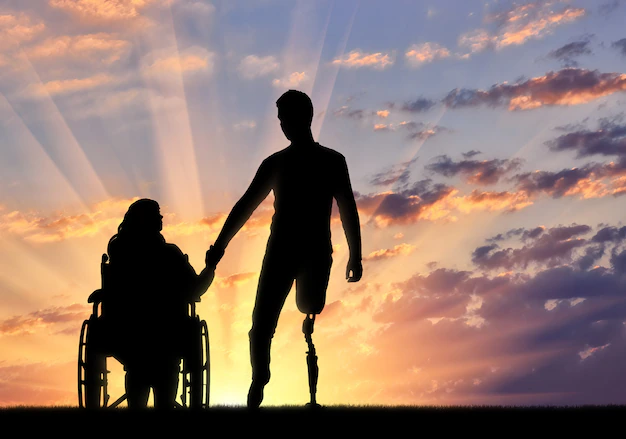Empowering Wellness – Staying Fit And Healthy With Disability Aids
Living with disabilities often means navigating life with the assistance of specialized tools and aids. However, the presence of these aids should never be a barrier to pursuing a fit and healthy lifestyle.
In fact, incorporating fitness routines and wellness practices is not only achievable but also essential for maintaining overall health and well-being. This tentative guide deals with the positive effects of exercise on disabled individuals and particularly focuses on its goals. So, let’s get started…
Embracing Adaptability in Fitness
Fitness doesn’t adhere to a one-size-fits-all approach. For individuals utilising disability aids, adapting fitness routines to suit personal needs is key. The journey to fitness begins with a clear understanding of one’s capabilities, aided by guidance from healthcare professionals and specialists.
The main thing to comprehend here is the difference between situational and environmental variables. While natural movement adapts to your direct environment inherently, adaptability helps to overcome a difficult fitness regime. Every situation where we work out is different, and the body must adapt to each one of them.
Customising Fitness Regimens
Tailoring workouts to accommodate different abilities is pivotal. Whether it’s chair exercises, water-based workouts, or modified yoga poses, there’s a spectrum of adaptable exercises. These exercises not only foster strength and flexibility but also contribute to cardiovascular health and mental well-being.
In simple terms, customized fitness regimens refer to workout programs that are specifically designed to address the fitness needs of a person. This indicates that there are considerations of gender, age, previous injuries, and present health status. Customizing them according to the body’s current needs will craft a sustainable workout plan.
Harnessing Technology and Innovation
The world of fitness is constantly evolving, and technological advancements have birthed innovative aids designed to facilitate workouts for individuals with disabilities. From accessible gym equipment to specialized fitness apps catering to diverse needs, technology plays a pivotal role in enhancing accessibility to fitness resources.
Modern fitness facilities increasingly offer a range of accessible equipment designed to accommodate various disabilities. Adjustable benches, hand-pedalled stationary bikes, and resistance bands are just a few examples. These aids foster inclusivity, enabling individuals to engage in workouts comfortably and effectively.
Assistive Apps and Online Resources
The digital landscape is brimming with apps and online platforms offering tailored workout routines, nutritional guidance, and mindfulness practices. Apps catering to specific disabilities provide step-by-step exercises, fostering independence and encouraging regular physical activity.
Prioritizing Mental and Emotional Well-being

Wellness extends beyond physical fitness—it encompasses mental and emotional health as well. For individuals utilizing disability aids, nurturing mental resilience and emotional well-being is equally important. In the hierarchy of the body’s fitness needs, both emotional and physical well-being play a crucial role.
Thankfully, there are various seminars and workshops for mental aid. There are professionals as well whom you can consult for any minor or major mental health issues. Prioritizing mental health is as important as paying heed to physical well-being.
Mindfulness and Meditation: Community Support and Engagement
Practicing mindfulness and meditation can significantly benefit mental health. Mindfulness exercises focus on being present in the moment, reducing stress and anxiety. Guided meditation sessions tailored to different needs are widely available and can be adapted to suit individual preferences.
Engaging with a supportive community can be a source of motivation and encouragement. Online forums, social media groups, and local support networks provide spaces to share experiences, seek advice, and celebrate achievements. Connecting with individuals facing similar challenges fosters a sense of belonging and solidarity.
In essence, incorporating fitness and wellness into daily routines for individuals using disability aids is a journey of adaptability, innovation, and holistic well-being. By embracing tailored fitness regimens, leveraging technological advancements, and prioritizing mental and emotional health, staying fit and healthy becomes an achievable and empowering endeavor.
Chair-Based Exercises
For those using wheelchairs or experiencing limited mobility, chair-based exercises offer a versatile and effective workout option. From seated leg lifts to modified arm curls using resistance bands, these exercises target various muscle groups without requiring standing or walking.
Water-Based Workouts
Water-based exercises in inaccessible pools or hydrotherapy settings provide a low-impact yet high-resistance environment. Water’s buoyancy reduces pressure on joints while offering resistance for muscle strengthening. Activities like water aerobics or simple movements in the pool can enhance cardiovascular fitness and flexibility.
Modified Yoga and Stretching
Yoga, with its emphasis on flexibility and mindfulness, can be adapted to accommodate diverse abilities. Modified poses or chair yoga sequences cater to individuals with mobility limitations while still reaping the benefits of improved balance, flexibility, and relaxation.
Nutrition Tips for Wellness
A balanced diet is fundamental for overall health. The body needs ample nutrition, and that should be included in all forms. Consider these tips to optimize nutrition and include a diet that is rich in all kinds of nutrition:
Personalized Meal Planning
Consulting a nutritionist or dietitian helps create personalized meal plans that cater to specific dietary needs. Whether adjusting for allergies, digestive issues, or specific health concerns, a customized approach ensures adequate nutrition.
Nutrient-Rich Foods
Prioritise nutrient-dense foods, including fruits, vegetables, lean proteins, and whole grains. These provide essential vitamins, minerals, and antioxidants necessary for optimal health.
Hydration
Maintaining proper hydration is crucial. Individuals with disabilities might have specific hydration needs, so monitoring water intake is vital, especially during workouts.
Conclusion
Staying fit and healthy while using disability aids is not only achievable but also enriching. By embracing adaptable fitness routines, leveraging technological aids, prioritizing mental well-being, and focusing on nutrition, individuals can lead fulfilling and vibrant lives.
The journey to wellness is unique for each person, but the common thread lies in determination, adaptability, and the unwavering commitment to prioritize one’s health despite challenges.
In the next segment of this blog series, we’ll delve deeper into specific workout routines, explore dietary guidelines in detail, and bring forth more inspiring stories of individuals who have thrived in their pursuit of fitness and wellness with the aid of disability aids. Stay tuned for more empowering insights and practical tips!
Read Also:
- The Future Of Healthcare: How Technological Advancements Are Revolutionizing The Industry
- Common Mistakes To Avoid When Filing A Disability Claim For A Health Condition
- The Role Of Proper Nutrition In Preventing Ketosis During Pregnancy



